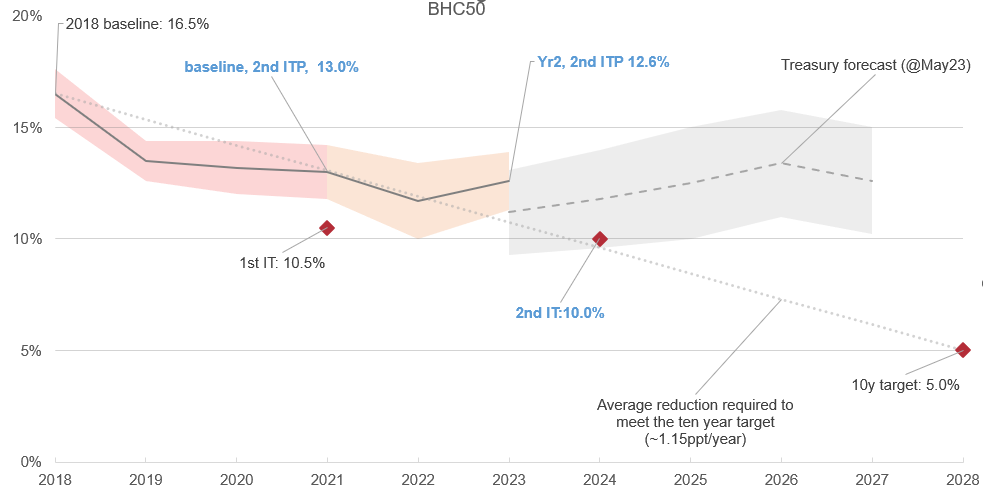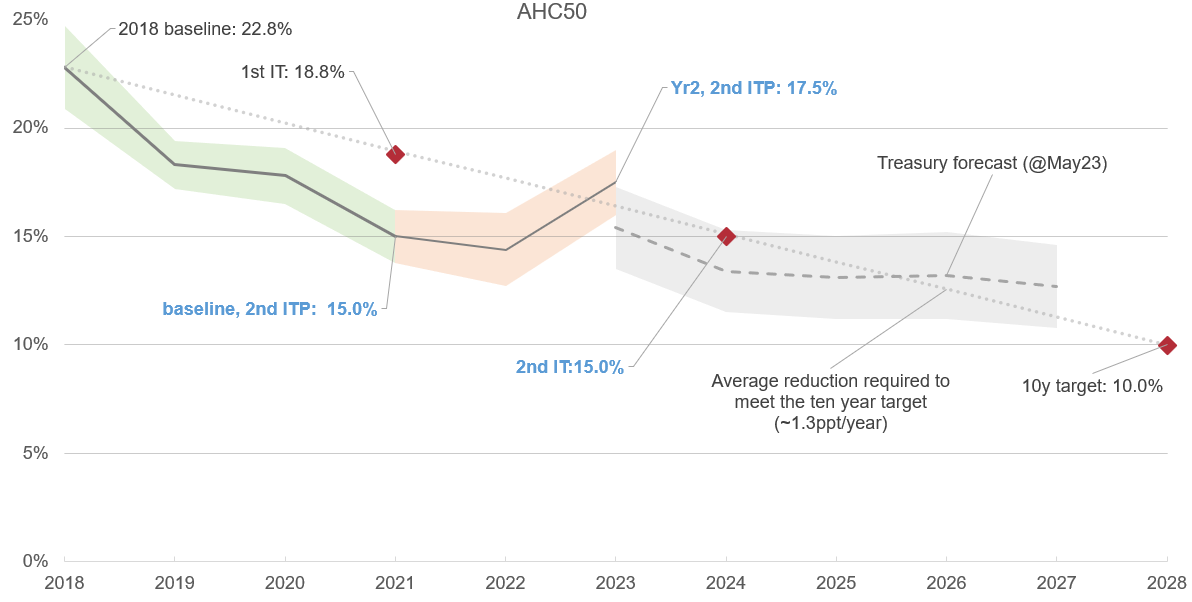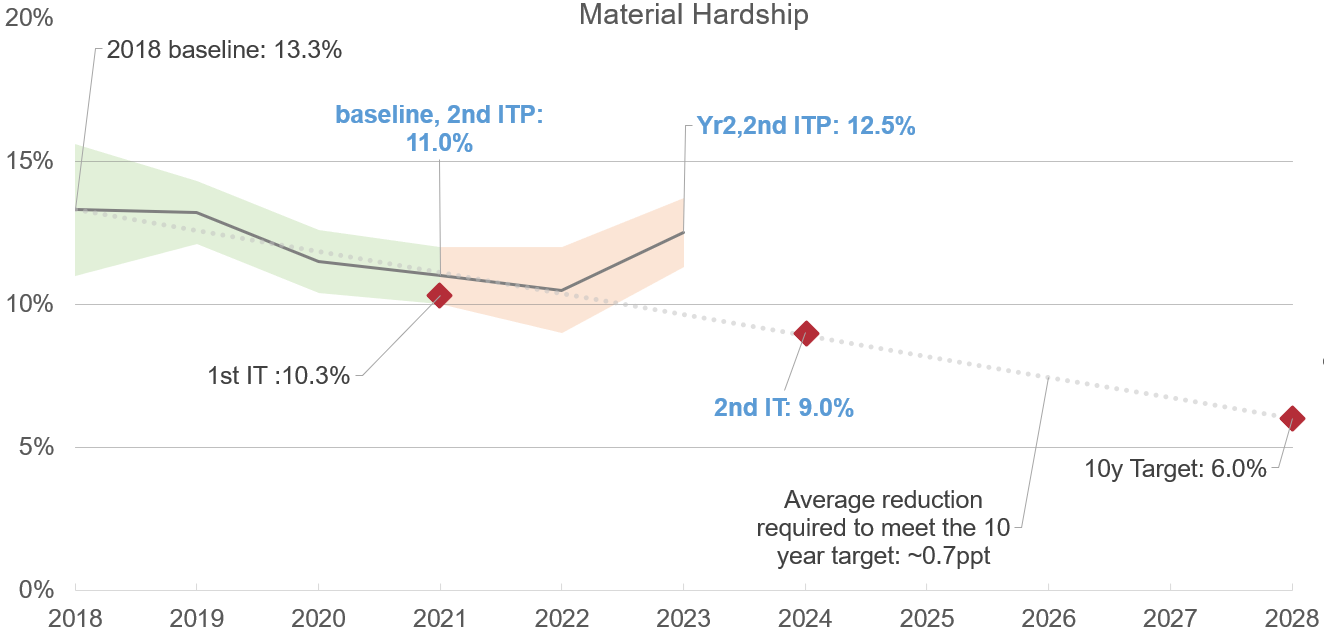IN-CONFIDENCE
Appendix 2-Briefing Review of the second intermediate child poverty
reduction targets
5. The most recent child poverty data for 2022/23 (the second year of the second intermediate
target period) shows that progress has been much slower than expected. In 2023 there have
been no statistical y significant changes on the material hardship and before-housing-costs
primary measures compared to the measured rates in the 2020/21 baseline year. Rates on
the after-housing-costs primary measure (AHC50) have statistically significantly increased.
6. The slower than expected progress on all three primary measures is largely due to the sharp
increases in cost-of-living pressures since mid-2022 and the fact that key policy decisions,
particularly those related to the review of Working for Families, were deferred or delayed.
28. The main other notable trend over the first two years of the second intermediate target
period was a sharp, and statistical y significant, year-on-year increase in poverty rates in
2022/23 on the AHC50 and material hardship measures. Taking into account sample error,
BHC50 poverty rates have been broadly stable over this period.



IN-CONFIDENCE
Figure1: Child poverty rates on the primary measures over the second intermediate target
period (2nd ITP)
IN-CONFIDENCE
Table 2: Progress over the second intermediate target period
Modelled and measured
Second intermediate target period
2020/21 baseline
Modelled
Measured
Measured
Measured
Measured
estimate
rate in
rate in
rate in
rate in
(2020) for
2020/21
2021/22
2022/23
2023/24
Primary
Second
2020/21
(subject to
(reported
measure
(year 1)
Intermediate
revision in
in Feb
Target
Feb 2024)
2025,
(year 2)
subject to
revision
in Feb
2026)
BHC50
12.6%
13.0%
11.7%
12.6%
(+/-1.2ppt)
(+/-1.7ppt)
(+/-1.3ppt)
n/a
10%
AHC50:
18.2%
15.0%
14.4%
17.5%
(+/-1.2ppt)
(+/-1.7ppt)
(+/-1.5ppt)
n/a
15%
Material
10.5%
12.5%
Hardship
n/a
11.0%
(+/-1.0)
(+/-1.5ppt)
(+/-1.2ppt)
n/a
9%
Two key factors have contributed to the slower than
expected progress
29. The slower than expected progress is a result of two main factors: cost of living increases,
and deferral of planned investments.
Sharp increases in the cost of living and borrowing costs, particularly for
working households
30. As noted in our recent advice to you on Stats NZ’s release of child poverty statistics for
2022/23 [DPMC-2023/24-743 refers], the living costs of low-income (quintile 1) households
increased by about 14 percent in the two years to 30 June 2023. This put substantial upward
pressure on rates on the AHC50 and material hardship measures – both of which are sensitive
to inflation.
31. Three quarters of the increase in material hardship rates between 2021/22 and 2022/23
was for children in working, rather than main benefit, households. High mortgage interest costs
likely partly contributed to this result: the share of children in mortgage-paying households in
material hardship (most of whom wil be in working families) increased from 11.6 percent to
19.0 percent in 2022/23. Also, low-income working households received comparatively less
generous increases in income support through the tax and transfer system compared to main
benefit households.
32. It’s notable, however, that as recently as May 2023, Treasury forecasts (which took into
account high actual and forecast inflation) indicated AHC50 poverty rates were expected to
remain steady in 2021/22, before slightly decreasing in 2022/23 and 2023/24 – to a level that
suggested that the 2023/24 targets would be comfortably met.
33. The May 2023, Treasury forecasts of BHC50 poverty rates indicated that poverty rates
could be expected to decrease in 2022/23, before increasing again in 2023/24 as median
incomes are expected to start to grow faster than the incomes of low-income households with
children.
IN-CONFIDENCE
Deferral of planned investments
34. A further contributor to the slower-than-planned progress is that key decisions and
investments were deferred or not made in time to be fully reflected in measured poverty rates
by 2023/24.
35. In particular, the review of Working for Families – seen as the “primary vehicle” for
achieving reductions – did not lead to changes of a scale that had been envisaged when the
targets were set. The most significant change, delivered from 1 April 2022, was a Family Tax
Credit (FTC) increase alongside an inflation adjustment, and a small abatement rate increase.
These changes combined led to a forecast reduction of 6000 children in poverty on the primary
income poverty measures. The eldest child FTC rate was increased by $15 per week, and $13
per week for subsequent children, and the abatement rate for the FTC and In Work Tax Credit
was increased from 25 percent to 27 percent.
36. Another key change, to enable sole parents on a benefit to receive child support payments,
was not implemented until mid-2023 and so is expected to have only a partial (~50 percent)
impact on measured poverty rates in 2023/24 (the final year of the second intermediate
targets).
Document Outline


